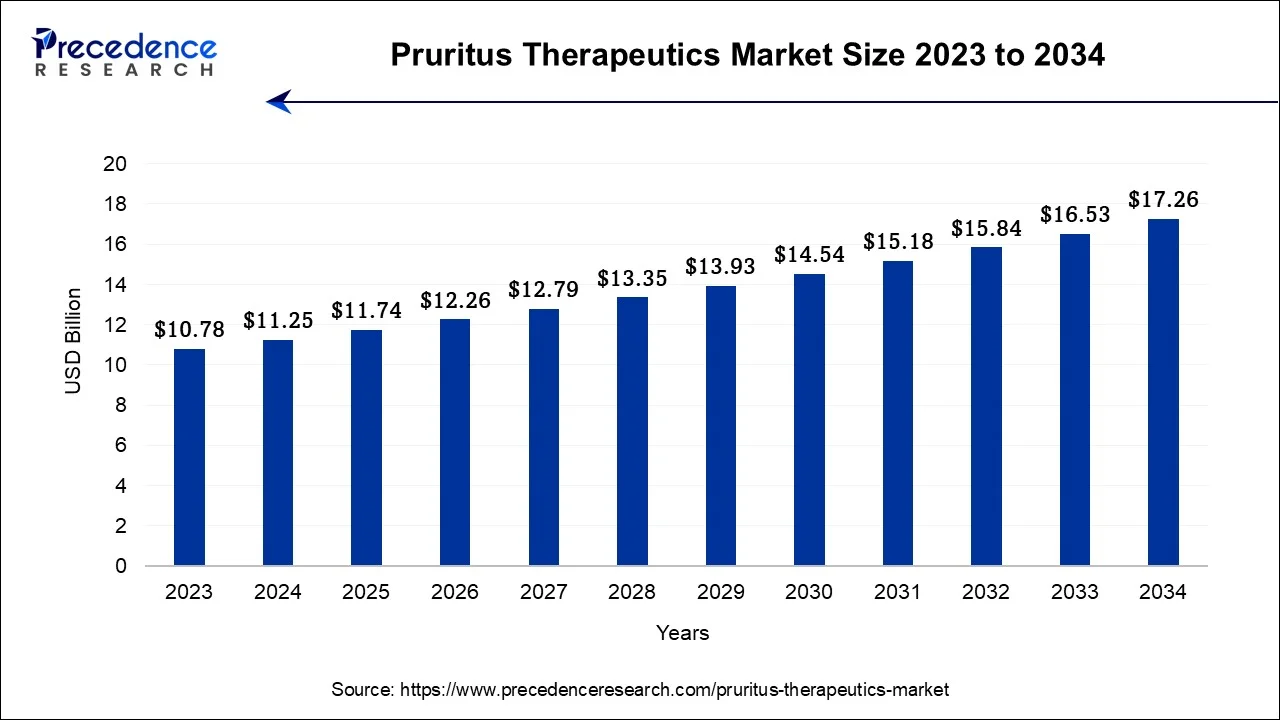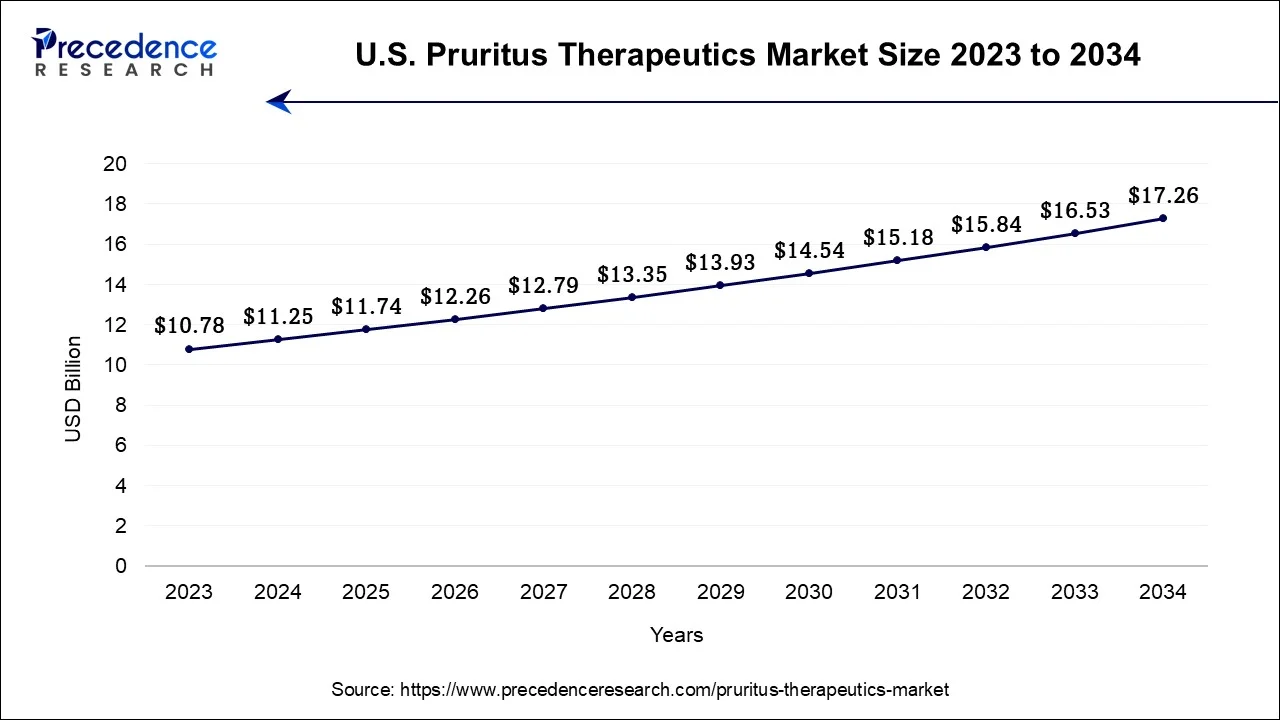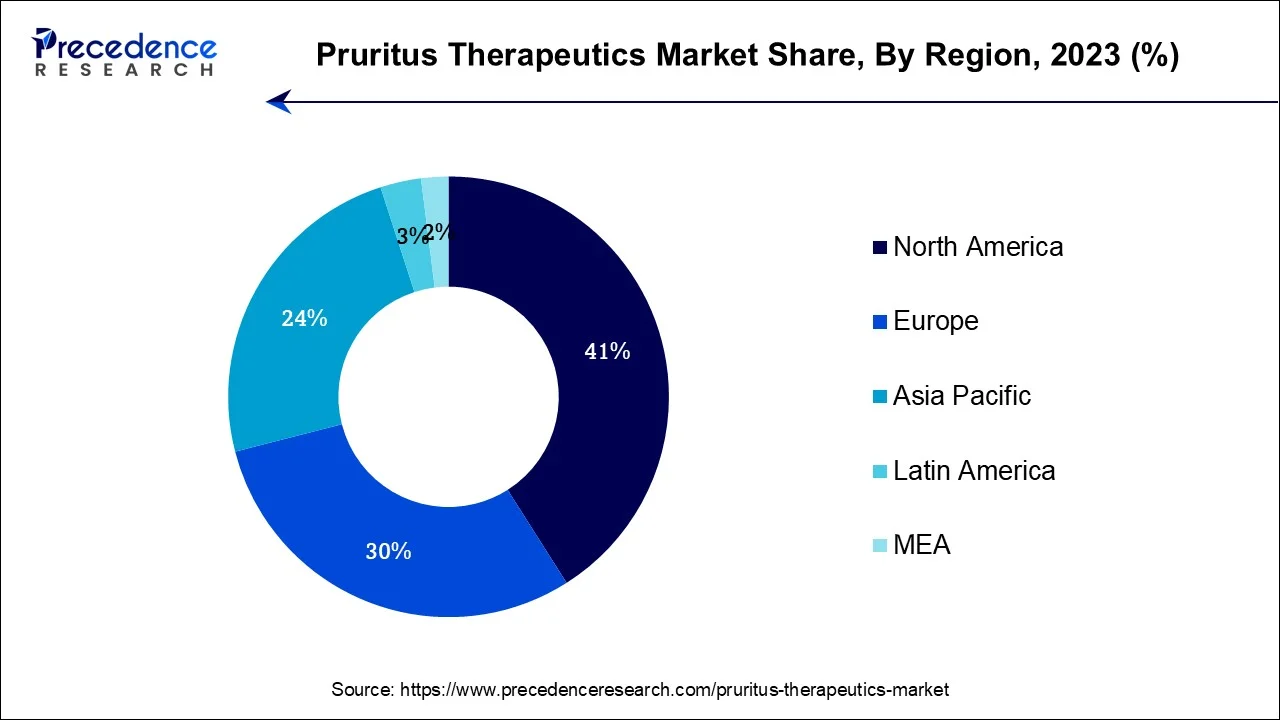September 2024
The global pruritus therapeutics market size accounted for USD 11.25 billion in 2024, grew to USD 11.74 billion in 2025 and is projected to surpass around USD 17.26 billion by 2034, representing a healthy CAGR of 4.37% between 2024 and 2034. The North America pruritus therapeutics market size is worth around USD 4.61 billion in 2024 and is expected to grow at a fastest CAGR of 4.38% during the forecast period.
The global pruritus therapeutics market size accounted for USD 11.25 billion in 2024, grew to USD 11.74 billion in 2025 and is projected to surpass around USD 17.26 billion by 2034, expanding CAGR of 4.37% between 2024 to 2034.

The U.S. pruritus therapeutics market size was exhibited at USD 3.23 billion in 2024 and is projected to be worth around USD 4.99 billion by 2034, poised to grow at a CAGR of 4.44% from 2024 to 2034.

North America is expected to dominate the market during the forecast period. The growth of the market in the region is attributed to the high prevalence of skin disorders including atopic dermatitis, psoriasis, contact dermatitis, and chronic urticaria. According to the National Psoriasis Foundation/USA, more than 8 million Americans have psoriasis. Psoriasis prevalence in African Americans is 1.5 percent compared to 3.6 percent of Caucasians. In addition, as per the American Academy of Dermatology Association, around 7.5 million people in the United States have psoriasis. Psoriasis occurs in all age groups but is primarily seen in adults, with the highest proportion between ages 45 and 64.
Moreover, the region has a rapidly ageing population, with a significant number of elderly individuals who are more prone to skin conditions like xerosis (dry skin) and pruritus. This demographic trend contributes to the demand for pruritus management. For instance, according to secondary sources, over the next 40 years, the number of Americans, especially the geriatric population (65 and older) will more than quadruple, reaching 80 million in 2040. Thus, this is expected to drive the market growth in the region.

Asia Pacific is expected to grow at the highest CAGR over the forecast period. The market growth in the region is owing to the fast and rapidly growing and improving healthcare infrastructure. Several countries in Asia Pacific are investing in expanding and improving their healthcare infrastructure with substantial support from respective governments, this element brings a potential for the pruritus market to expand in the region for the upcoming period. This includes the development of specialized dermatology clinics and centers, which play a pivotal role in pruritus diagnosis and treatment. Moreover, pharmaceutical companies and research institutions in Asia Pacific are increasingly engaged in research and development efforts to create innovative pruritus therapeutics tailored to the specific needs of the local population. Therefore, this is expected to propel the pruritus therapeutics market growth in the Asia Pacific region.
Pruritus therapeutics refers to the various medical treatments, interventions, and therapies employed to alleviate pruritus, commonly known as itching. Pruritus therapeutics are designed to provide relief from itching, reduce inflammation, and address the root causes of pruritus when possible. These therapeutics encompass a wide range of treatment modalities, including topical medications, oral drugs, biological therapies, phototherapy, and lifestyle modifications. The global pruritus therapeutics market revolves around the research, development, innovation and distribution of sedative and non-sedative medicines, drugs or other therapeutics for relief of pruritus.
The choice of treatment depends on the underlying cause of pruritus, its severity, and the patient’s overall health. The pruritus market growth is driven by various factors including the growing prevalence of pruritus disease and the growing aging population across the globe.
Moreover, the global pruritus therapeutics market is observed to be accelerated by the increased awareness about skin diseases, innovation in the dermatology sector, presence of rapid diagnosis services in urban areas, advancements in research, growing regulatory approvals and development of innovative therapies.
| Report Coverage | Details |
| Market Size by 2034 | USD 17.26 Billion |
| Market Size in 2024 | USD 11.25 Billion |
| Growth Rate from 2024 to 2034 | CAGR of 4.37% |
| Largest Market | North America |
| Base Year | 2024 |
| Forecast Period | 2024 to 2034 |
| Segments Covered | Disease Type, Product, Distribution Channel, and Regions |
| Regions Covered | North America, Europe, Asia-Pacific, Latin America, and Middle East & Africa |
Growing prevalence of pruritus disease
Pruritus is a common symptom associated with various medical conditions, including dermatological disorders (eczema and psoriasis), systemic diseases (liver and kidney diseases), and autoimmune conditions (lupus). As the incidence of these conditions increases, so does the prevalence of pruritus, driving the demand for therapeutic solutions. For instance, according to the Lupus Foundation of America, a particular form of lupus affects at least five million people worldwide. Whereas around 1.5 million Americans are affected by the same. Lupus was also one of the top 20 fatalities of women between the ages of 5 and 64. Thus, the aforementioned stats drive the market growth over the projection period.
Restraint:
Complex and diverse causes
Pruritus can have numerous underlying causes, ranging from dermatological conditions to systematic diseases. The complexity and diversity of these causes make it challenging to develop a one-size-fits-all treatment approach. Tailoring treatments to the specific cause of pruritus can be difficult. Thus, this is acting as a major restraining factor to the market growth during the projected period.
Increasing discoveries and product innovations
Global private players have increased their investment in research and development of novel medications and therapies as a result of the rising demand for pruritus medicines. Given the rising prevalence of skin disorders and conditions globally, the potential for profiting from the expanding pruritus industry has prompted major market participants to create promising and efficient medications. Similar to this, the regulatory authorities were convinced to speed up approvals to protect the interests of consumers by the discovery and rising prevalence of novel skin diseases. The market for pruritus therapies will expand due to the standardization and simplification of regulatory approvals and licensing. Additionally, several collaborations, mergers and acquisitions to develop therapies will stimulate market growth.
Tthe global pruritus therapeutics market is segmented into atopic dermatitis, urticarial, allergic contact dermatitis and others. The atopic dermatitis segment held the largest market share in 2022 and is expected to continue the same pattern during the forecast period. Atopic dermatitis (AD), also known as eczema, is a common skin condition characterized by red, itchy rashes that often appear on the face, hands, elbows, and knees.
It is a significant contributor to the pruritus therapeutics market due to its high prevalence and the severe itching associated with the condition. According to the National Eczema Association, eczema is present in 31.6 million Americans (10.1%), and it is most common in young children. Eczema is thought to affect 1 in 10 people at some point in their lives, with early infancy being the most common time for occurrence. A conclusive diagnosis for atopic dermatitis (AD) was made in 60% of cases within a year of the onset of symptoms. For adult-onset AD, the delay in diagnosis was more severe, with over 20% of adults stating that it took longer than two years, compared to less than 10% of children under the age of 18.
The urticaria segment is expected to grow at the fastest rate over the forecast period. Urticaria, commonly known as hives, is a skin condition characterized by the sudden appearance of red and itchy wheals on the skin. These welts can vary in size and shape and may come and go over hours to days. Urticaria is a significant contributor to the pruritus therapeutics market due to the intense itching and discomfort it causes. This is a common skin condition that affects people of all ages. Acute urticaria can occur in response to various triggers, while chronic urticaria can persist for six weeks or longer. The itching associated with urticaria is a primary driver for seeking pruritus therapeutics. Thereby, driving the segment’s growth.
The global pruritus therapeutics market is segmented into calcineurin inhibitors, corticosteroids, local anesthetics, counterirritants, antihistamines, immunosuppressant and others. The corticosteroids segment is expected to capture the highest revenue share over the forecast period. Corticosteroids are a class of medications that play a significant role in the Pruritus Therapeutics market, particularly for various skin conditions associated with itching (pruritus). These medications are commonly used to alleviate itching, inflammation, and other symptoms in a range of dermatological conditions.
Corticosteroids are one of the most versatile and widely prescribed treatments for dermatological conditions that involve itching. They are effective in reducing inflammation, itching, and redness associated with skin disorders like eczema, psoriasis, contact dermatitis, and allergic reactions. Moreover, these medicines are available in different formulations, including creams, ointments, gels, sprays, and foams. This variety of options ensures that patients can find a suitable product for their specific needs and preferences. Thus, this is expected to drive the segment growth.
Based on the distribution channel, the global pruritus therapeutics market is segmented into hospital pharmacies, drug stores & retail pharmacies and online providers. The hospital pharmacies segment is expected to dominate the market during the forecast period. Hospital pharmacies dispense prescription pruritus therapeutics, including topical creams, oral medications, and other treatments, to inpatients and outpatients under the care of hospital staff or specialists.
Moreover, in a hospital setting, patients often require immediate relief from pruritus due to various underlying medical conditions or treatments. Hospital pharmacies ensure that essential pruritus medications are readily available to provide quick relief. Furthermore, in certain cases, patients with severe or complex pruritus may require customized formulations of medications. Hospital pharmacies can compound and tailor pruritus therapeutics to meet individual patient needs. Thus, these benefits of hospital pharmacies drive market growth.
Segments Covered in the Report
By Disease Type
By Product
By Distribution Channel
By Geography
For inquiries regarding discounts, bulk purchases, or customization requests, please contact us at sales@precedenceresearch.com
No cookie-cutter, only authentic analysis – take the 1st step to become a Precedence Research client
September 2024
August 2024
October 2024
March 2025